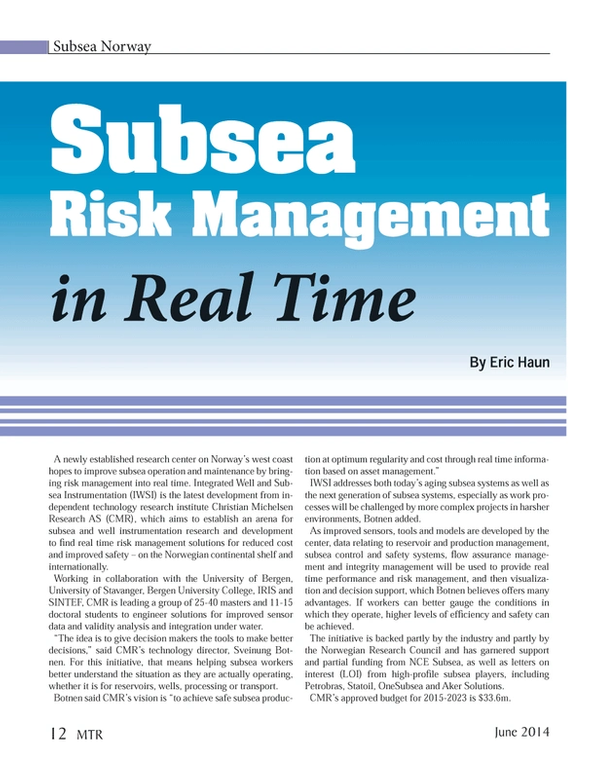
Subsea Risk Management in Real Time
A newly established research center on Norway’s west coast hopes to improve subsea operation and maintenance by bringing risk management into real time. Integrated Well and Subsea Instrumentation (IWSI) is the latest development from independent technology research institute Christian Michelsen Research AS (CMR), which aims to establish an arena for subsea and well instrumentation research and development to find real time risk management solutions for reduced cost and improved safety – on the Norwegian continental shelf and internationally.
Working in collaboration with the University of Bergen, University of Stavanger, Bergen University College, IRIS and SINTEF, CMR is leading a group of 25-40 masters and 11-15 doctoral students to engineer solutions for improved sensor data and validity analysis and integration under water.
“The idea is to give decision makers the tools to make better decisions,” said CMR’s technology director, Sveinung Botnen. For this initiative, that means helping subsea workers better understand the situation as they are actually operating, whether it is for reservoirs, wells, processing or transport.
Botnen said CMR’s vision is “to achieve safe subsea production at optimum regularity and cost through real time information based on asset management.”
IWSI addresses both today’s aging subsea systems as well as the next generation of subsea systems, especially as work processes will be challenged by more complex projects in harsher environments, Botnen added.
As improved sensors, tools and models are developed by the center, data relating to reservoir and production management, subsea control and safety systems, flow assurance management and integrity management will be used to provide real time performance and risk management, and then visualization and decision support, which Botnen believes offers many advantages. If workers can better gauge the conditions in which they operate, higher levels of efficiency and safety can be achieved.
The initiative is backed partly by the industry and partly by the Norwegian Research Council and has garnered support and partial funding from NCE Subsea, as well as letters on interest (LOI) from high-profile subsea players, including Petrobras, Statoil, OneSubsea and Aker Solutions.
CMR’s approved budget for 2015-2023 is $33.6m.
(As published in the June 2014 edition of Marine Technology Reporter - http://www.marinetechnologynews.com/Magazine)
Read Subsea Risk Management in Real Time in Pdf, Flash or Html5 edition of June 2014 Marine Technology
Other stories from June 2014 issue
Content
- Editor's Note: MTR June 2014 page: 6
- Several Contracts for DOF Subsea page: 8
- Subsea: Standardization is the New Innovation page: 10
- Subsea Risk Management in Real Time page: 12
- Maersk Computer Game to Spark Students' Interest in Science page: 14
- FORCE: Tidal Project Begins Construction on Subsea Platform page: 18
- AUVs are Central to Lisbon Security Program page: 18
- Study: Rising Sea Level Puts 150 Million at Risk page: 22
- Insights into Inertial Sensor Technology page: 26
- ONR and the Culture of Innovation and Invention page: 30
- Preparing Engineers for Lucrative Ocean Related Careers page: 38
- C-MAR DP Training in Brazil page: 40
- Exceptional Imagery via Bluefin Robotics AUV & Sonardyne Solstice page: 42
- Oil Majors Increasingly Employ eLearning Tools page: 44
- VectorNav Launches VN-300 page: 53
- Trelleborg Debuts Thermal Insulation Portfolio page: 54
- Subsea Camera from Battelle page: 55
- MacArtney Launches LUXUS Dropplate page: 55
- WFS: Improved Subsea Video Camera page: 56
- GPRS Enabled Security Camera from OSIL page: 56
- Sonar Image Stabilization – A Powerful Tool page: 57
- Bowtech Releases New Tooling Camera Range page: 57
- Imenco and High Resolution Subsea Digital Imaging page: 57
- Axis: New Security Cameras page: 58
- New Submersible Pressure Sensor from AST page: 59
- Sonardyne System to Monitor North Sea CO2 Leaks page: 59


